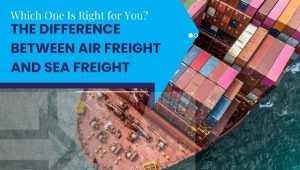
When moving internationally, one of the biggest decisions you’ll make is how to transport your belongings: air freight or sea freight. Both methods have their advantages and drawbacks, and the right choice depends on your budget, timeline, and what you’re shipping.
For first-time expats and even seasoned movers, the terms can be confusing. Do you pay more for the speed of air freight, or save money with sea freight? This guide breaks down the key differences so you can make an informed choice that suits your relocation needs.
What Is Air Freight?
Air freight is the transportation of goods by aircraft. For international moves, your items are packed, cleared through customs, and loaded onto a commercial or cargo plane.
Key advantages:
- Speed: The fastest way to move belongings internationally, often within days.
- Reliability: Airlines follow strict schedules, making delays less common.
- Security: Airports have strong security measures, reducing theft or damage risks.
- Best for small shipments: Ideal for moving essentials, urgent items, or high-value goods.
Limitations:
- Cost: Air freight can be up to 10 times more expensive than sea freight.
- Volume restrictions: Limited cargo space makes it unsuitable for large household moves.
- Environmental impact: Air transport has a higher carbon footprint compared to sea.
What Is Sea Freight?
Sea freight (or ocean freight) is the shipping of goods in containers via cargo vessels. For relocations, items are packed into either a Full Container Load (FCL) or Less than Container Load (LCL).
Key advantages:
- Cost-effective: Much cheaper for large shipments.
- Capacity: Containers can hold entire households, vehicles, and bulky items.
- Flexibility: Options for FCL (exclusive use) or LCL (shared container).
- Better for non-urgent moves: Works well when delivery timelines are flexible.
Limitations:
- Transit time: Shipping by sea can take weeks to months depending on distance and port traffic.
- Potential delays: Weather, customs backlogs, or port congestion can slow things down.
- Complex logistics: More paperwork and coordination required.
Cost Comparison
One of the biggest deciding factors is cost.
- Air freight: Charged by weight and volume, making it expensive for bulky items. For example, moving a small pallet of electronics may cost thousands of dollars by air.
- Sea freight: Charged mainly by container size (20ft or 40ft), not by individual item weight. A full household move is usually far more affordable by sea.
Tip: Many expats use a combination — sending essentials by air and the rest by sea.
Speed Comparison
- Air freight: Typically 2–10 days door-to-door, depending on distance.
- Sea freight: Can take 4–12 weeks, depending on origin, destination, and customs clearance.
If you need furniture, clothing, or equipment quickly, air freight is the obvious choice. For non-essential items, sea freight is usually worth the wait.
Volume and Weight Considerations
- Air freight: Best for shipments under 200–300kg. Anything larger becomes prohibitively expensive.
- Sea freight: Suitable for entire households, vehicles, or bulky furniture. Containers can hold thousands of kilograms.
Think about whether you’re moving just a few boxes or an entire household.
Customs and Paperwork
Both methods require customs clearance, but sea freight often involves more documentation. Incorrect paperwork can cause delays and storage fees at the port.
Professional movers like CM Relocation guide you through the process, ensuring documents like inventories, packing lists, and permits are prepared correctly.
Environmental Impact
For eco-conscious movers, sea freight is more sustainable. A single container ship can carry thousands of containers, making the carbon footprint per shipment much lower than air transport.
When to Choose Air Freight
Air freight is ideal if:
- You’re moving urgently for work or family reasons.
- You have a small shipment of essentials.
- Items are high-value or fragile and require extra care.
- You want fast, predictable delivery.
Examples: personal documents, electronics, work equipment, or seasonal clothing.
When to Choose Sea Freight
Sea freight is ideal if:
- You’re moving an entire household.
- You’re relocating long-term and need furniture, appliances, or vehicles.
- You want the most cost-effective option.
- You’re flexible on timelines.
Examples: household goods, cars, large furniture, and bulkier personal effects.
Combining Air and Sea Freight
Many first-time expats don’t realise they can use both methods together. A “split shipment” strategy allows you to:
- Send immediate necessities (work clothes, documents, laptops) by air.
- Ship larger, non-urgent belongings (furniture, appliances, cars) by sea.
This hybrid approach balances speed and cost, ensuring you have what you need right away while waiting for the rest to arrive.
Questions to Ask Your Moving Company
When deciding between air and sea freight, ask your mover:
- What are the estimated transit times for both options?
- Are port handling and customs fees included in the quote?
- What’s the insurance coverage for each method?
- Can I combine air and sea freight in one move?
- How do you handle delays or unexpected charges?
A good relocation company will give clear answers and guide you to the best solution for your situation.
Choosing between air freight and sea freight comes down to balancing speed, cost, and shipment size. Air freight offers speed and security, but at a higher price. Sea freight is affordable and suitable for large moves, but requires patience and planning.
For many expats, the right choice is a combination of both, with essentials by air and household items by sea.
With the guidance of a trusted relocation company like CM Relocation, you can make the best decision for your budget, lifestyle, and timeline. Whether you need speed, affordability, or a mix of both, professional movers ensure your belongings arrive safely and your transition abroad is seamless.
